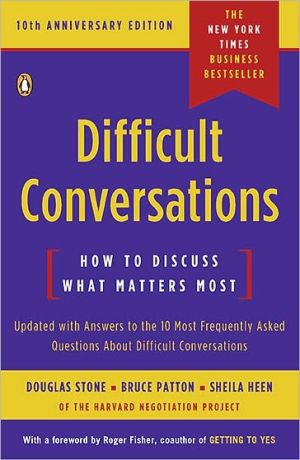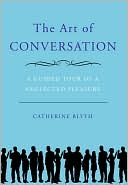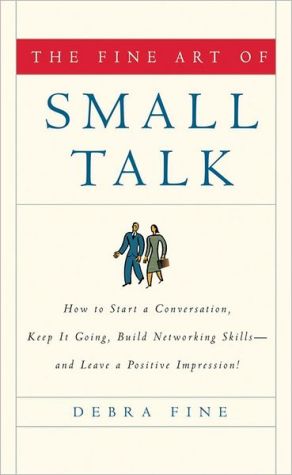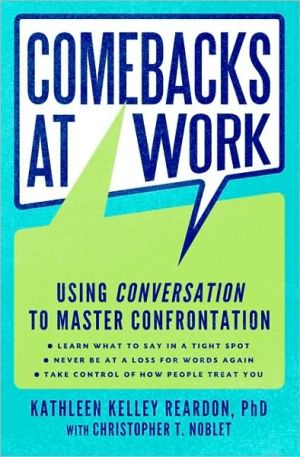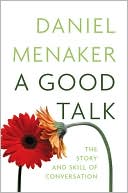Difficult Conversations: How to Discuss What Matters Most
The 10th-anniversary edition of the New York Times business bestseller-now updated with "Answers to Ten Questions People Ask" \ We attempt or avoid difficult conversations every day-whether dealing with an underperforming employee, disagreeing with a spouse, or negotiating with a client. From the Harvard Negotiation Project, the organization that brought you Getting to Yes, Difficult Conversations provides a step-by-step approach to having those tough conversations with less stress and more...
Search in google:
What is a difficult conversation? Asking for a raise. Ending a relationship. Saying "no" to your boss or spouse. Confronting disrespectful behavior. Apologizing. Conversations we dread, and often handle clumsily as a result, are part of all our lives: in boardrooms and family rooms, across the negotiation table and the dinner table. Now, Difficult Conversations teaches us how to handle these dialogues with more success and less anxiety. How does it work? Based on fifteen years of research and consultations with thousands of people, Difficult Conversations pinpoints what works. The authors discovered that regardless of context, the same small but crucial errors are what trip us up — and a few key adjustments can make all the difference. * The role of emotions — ours and theirs * The impact of what is said and what is not said * Why admitting our mistakes will put us in a stronger position * The truth behind the myth that women are better at expressing their emotions than men * How to respond productively in the face of personal attacks Who is this for? Filled with examples from everyday life, Difficult Conversations is certain to be an instant and lasting classic for families, neighbors, bosses, employees, customers, tenants, landlords, psychologists, teachers, and more. Who are the authors? Douglas Stone, Bruce Patton, and Sheila Heen teach at Harvard Law School and at the Harvard Negotiation Project. They have consulted to countless businesspeople, governments, organizations, and communities including all parties to the negotiations on constitutional transition in South Africa; school teachers in Medellin, Colombia; and community leaders and the police department in Springfield, Massachusetts. They lecture throughout the world and have written on negotiation, conflict resolution, and communication. Bruce Patton is co-author of Getting to Yes. Library Journal Stone and his coauthors, teachers at Harvard Law School and the Harvard Negotiation Project, present an informative, practical guide to the art of handling difficult conversations--e.g., firing an employee, ending a relationship, or discussing marital conflicts. The information is based on 15 years of research and thousands of personal interviews. The authors define a difficult conversation as "anything you find it hard to talk about." Each chapter recommends step-by-step techniques that can lead to a more constructive approach for dealing with distressing interactions, so that a difficult conversation can become a learning conversation. Examples of right and wrong conversations from everyday life are used throughout the book, which is extremely well organized and easy to follow. This will be appreciated by readers who wish to improve oral communication in all aspects of their daily lives. Recommended for self-help collections in public and academic libraries.--Elizabeth Goeters, Georgia Perimeter Coll., Dunwoody
\ \ \ \ \ Chapter One\ \ \ Sort Out the Three Conversations\ \ \ Jack is about to have a difficult conversation.\ He explains: "Late one afternoon I got a call from Michael, a good friend and occasional client. `I'm in a tight spot,' he told me. `I need a financial brochure laid out and printed by tomorrow afternoon.' He said his regular designer was out and that he was under a lot of pressure.\ "I was in the middle of another project, but Michael was a friend, so I dropped everything and worked late into the night on his brochure.\ "Early the next morning Michael reviewed the mock-up and gave the go-ahead to have it printed. I had the copies on his desk by noon. I was exhausted, but I was glad I'd been able to help him out.\ "Then I got back to my office and discovered this voice-mail message from Michael:\ \ \ Well, you really screwed this one up! Look, Jack, I know you were under time pressure on this, but.... [sigh]. The earnings chart isn't presented clearly enough, and it's slightly off. It's just a disaster. This is an important client. I assume you'll fix it right away. Give me a call as soon as you get in.\ \ \ "Well, you can imagine how I felt about that message. The chart was off, but microscopically. I called Michael right away."\ Their conversation went like this:\ \ \ Jack: Hi, Michael, I got your message —\ Michael: Yeah, look Jack, this thing hasto be done over.\ Jack: Well, wait a second. I agree it's not perfect, but the chart is clearly labeled. Nobody's going to misunderstand —\ Michael: C'mon, Jack. You know as well as I do that we can't send this thing out like this.\ Jack: Well, I think that —\ Michael: There's really nothing to argue about here. Look, we all screw up. Just fix it and let's move on.\ Jack: Why didn't you say something about this when you looked at it this morning?\ Michael: I'm not the one who's supposed to be proofreading. Jack, I'm under tremendous pressure to get this done and to get it done right. Either you're on the team or you're not. I need a yes or a no. Are you going to redo it?\ Jack: [pause] Alright, alright. I'll do it.\ \ \ This exchange has all the hallmarks of a difficult conversation going off the rails. Months later, Jack still feels lousy about this conversation and his relationship with Michael remains strained. He wonders what he could have done differently, and what he should do about it now.\ But before we get to that, let's look at what Jack and Michael's conversation can teach us about how difficult conversations work.\ \ \ Decoding the Structure of Difficult Conversations\ \ \ Surprisingly, despite what appear to be infinite variations, all difficult conversations share a common structure. When you're caught up in the details and anxiety of a particular difficult conversation, this structure is hard to see. But understanding that structure is essential to improving how you handle your most challenging conversations.\ \ \ There's More Here Than Meets the Ear\ \ \ In the conversation between Jack and Michael recounted above, the words reveal only the surface of what is really going on. To make the structure of a difficult conversation visible, we need to understand not only what is said, but also what is not said. We need to understand what the people involved are thinking and feeling but not saying to each other. In a difficult conversation, this is usually where the real action is.\ Look at what Jack is thinking and feeling, but not saying, as this conversation proceeds:\ \ \ What Jack Thought and Felt But Didn't Say\ How could he leave a message like that?! After I drop everything, break a dinner date with my wife, and stay up all night, that's the thanks I get?!\ \ \ A total overreaction. Not even a CPA would be able to tell that the graph is off. At the same time, I'm angry with myself for making such a stupid mistake.\ \ \ Michael tries to intimidate colleagues into getting his way. But he shouldn't treat me that way. I'm a friend! I want to stand up for myself, but I don't want to get into a big fight about this. I can't afford to lose Michael as a client or as a friend. I feel stuck.\ \ \ Screw up!? This isn't my fault. You approved it, remember?\ \ \ Is that how you see me? As a proofreader?\ \ \ I'm sick of this whole thing. I'm going to be bigger than whatever pettiness is driving him. The best way out is for me just to be generous and redo it.\ \ \ What Jack and Michael Actually Said\ \ \ Jack: Hi, Michael, I got your message —\ Michael: Yeah, look Jack, this\ thing has to be done over.\ \ \ \ Jack: Well, wait a second. I agree it's not perfect, but the chart is clearly labeled. Nobody's going to misunderstand —\ Michael: C'mon, Jack, you know as well as I do that we can't send this thing out like this.\ \ \ Jack: Well, I think that —\ Michael: There's really nothing to argue about here. Look, we all screw up. Just fix it and let's move on.\ Jack: Why didn't you say something about this when you looked at it this morning?\ Michael: I'm not the one who's supposed to be proofreading. I'm under tremendous pressure to get this done and to get it done right. Either you're on the team or you're not. I need a yes or a no. Are you going to redo it?\ \ \ Jack: [pause] Alright, alright. I'll do it.\ \ \ Meanwhile, there's plenty that Michael is thinking and feeling but not saying. Michael is wondering whether he should have hired Jack in the first place. He hasn't been all that happy with Jack's work in the past, but he decided to go out on a limb with his partners to give his friend another chance. Michael is now frustrated with Jack and confused about whether hiring Jack was a good decision — personally or professionally.\ The first insight, then, is a simple one: there's an awful lot going on between Jack and Michael that is not being spoken.\ That's typical. In fact, the gap between what you're really thinking and what you're saying is part of what makes a conversation difficult. You're distracted by all that's going on inside. You're uncertain about what's okay to share, and what's better left unsaid. And you know that just saying what you're thinking would probably not make the conversation any easier.\ \ \ Each Difficult Conversation Is Really Three Conversations\ \ \ In studying hundreds of conversations of every kind we have discovered that there is an underlying structure to what's going on, and understanding this structure, in itself, is a powerful first step in improving how we deal with these conversations. It turns out that no matter what the subject, our thoughts and feelings fall into the same three categories, or "conversations." And in each of these conversations we make predictable errors that distort our thoughts and feelings, and get us into trouble.\ Everything problematic that Michael and Jack say, think, and feel falls into one of these three "conversations." And everything in your difficult conversations does too.\ \ \ 1. The "What Happened?" Conversation. Most difficult conversations involve disagreement about what has happened or what should happen. Who said what and who did what? Who's right, who meant what, and who's to blame? Jack and Michael tussle over these issues, both out loud and internally. Does the chart need to be redone? Is Michael trying to intimidate Jack? Who should have caught the error?\ \ \ 2. The Feelings Conversation. Every difficult conversation also asks and answers questions about feelings. Are my feelings valid? Appropriate? Should I acknowledge or deny them, put them on the table or check them at the door? What do I do about the other person's feelings? What if they are angry or hurt? Jack's and Michael's thoughts are littered with feelings. For example, "This is the thanks I get?!" signals hurt and anger, and "I'm under tremendous pressure" reveals anxiety. These feelings are not addressed directly in the conversation, but they leak in anyway.\ \ \ 3. The Identity Conversation This is the conversation we each have with ourselves about what this situation means to us. We conduct an internal debate over whether this means we are competent or incompetent, a good person or bad, worthy of love or unlovable. What impact might it have on our self-image and self-esteem, our future and our well-being? Our answers to these questions determine in large part whether we feel "balanced" during the conversation, or whether we feel off-center and anxious. In the conversation between Jack and Michael, Jack is struggling with the sense that he has been incompetent, which makes him feel less balanced. And Michael is wondering whether he acted foolishly in hiring Jack.\ \ \ Every difficult conversation involves grappling with these Three Conversations, so engaging successfully requires learning to operate effectively in each of the three realms. Managing all three simultaneously may seem hard, but it's easier than facing the consequences of engaging in difficult conversations blindly.\ \ \ What We Can't Change, and What We Can\ \ \ No matter how skilled we become, there are certain challenges in each of the Three Conversations that we can't change. We will still run into situations where untangling "what happened" is more complicated than we initially suspect. We will each have information the other person is unaware of, and raising each other's awareness is not easy. And we will still face emotionally charged situations that feel threatening because they put important aspects of our identity at risk.\ What we can change is the way we respond to each of these challenges. Typically, instead of exploring what information the other person might have that we don't, we assume we know all we need to know to understand and explain things. Instead of working to manage our feelings constructively, we either try to hide them or let loose in ways that we later regret. Instead of exploring the identity issues that may be deeply at stake for us (or them), we proceed with the conversation as if it says nothing about us — and never come to grips with what is at the heart of our anxiety.\ By understanding these errors and the havoc they wreak, we can begin to craft better approaches. Let's explore each conversation in more depth.\ \ \ The "What Happened?" Conversation: What's the Story Here?\ \ \ The "What Happened?" Conversation is where we spend much of our time in difficult conversations as we struggle with our different stories about who's right, who meant what, and who's to blame. On each of these three fronts — truth, intentions, and blame — we make a common but crippling assumption. Straightening out each of these assumptions is essential to improving our ability to handle difficult conversations well.\ \ \ The Truth Assumption\ \ \ As we argue vociferously for our view, we often fail to question one crucial assumption upon which our whole stance in the conversation is built: I am right, you are wrong. This simple assumption causes endless grief.\ What am I right about? I am right that you drive too fast. I am right that you are unable to mentor younger colleagues. I am right that your comments at Thanksgiving were inappropriate. I am right that the patient should have received more medication after such a painful operation. I am right that the contractor overcharged me. I am right that I deserve a raise. I am right that the brochure is fine as it is. The number of things I am right about would fill a book.\ There's only one hitch: I am not right.\ How could this be so? It seems impossible. Surely I must be right sometimes!\ Well, no. The point is this: difficult conversations are almost never about getting the facts right. They are about conflicting perceptions, interpretations, and values. They are not about what a contract states, they are about what a contract means. They are not about which child-rearing book is most popular, they are about which child-rearing book we should follow.\ They are not about what is true, they are about what is important.\ Let's come back to Jack and Michael. There is no dispute about whether the graph is accurate or not. They both agree it is not. The dispute is over whether the error is worth worrying about and, if so, how to handle it. These are not questions of right and wrong, but questions of interpretation and judgment. Interpretations and judgments are important to explore. In contrast, the quest to determine who is right and who is wrong is a dead end.\ In the "What Happened?" Conversation, moving away from the truth assumption frees us to shift our purpose from proving we are right to understanding the perceptions, interpretations, and values of both sides. It allows us to move away from delivering messages and toward asking questions, exploring how each person is making sense. of the world. And to offer our views as perceptions, interpretations, and values — not as "the truth."\ \ \ The Intention Invention\ \ \ The second argument in the "What Happened?" Conversation is over intentions — yours and mine. Did you yell at me to hurt my feelings or merely to emphasize your point? Did you throw my cigarettes out because you're trying to control my behavior or because you want to help me live up to my commitment to quit? What I think about your intentions will affect how I think about you and, ultimately, how our conversation goes.\ The error we make in the realm of intentions is simple but profound: we assume we know the intentions of others when we don't. Worse still, when we are unsure about someone's intentions, we too often decide they are bad.\ The truth is, intentions are invisible. We assume them from other people's behavior. In other words, we make them up, we invent them. But our invented stories about other people's intentions are accurate much less often than we think. Why? Because people's intentions, like so much else in difficult conversations, are complex. Sometimes people act with mixed intentions. Sometimes they act with no intention, or at least none related to us. And sometimes they act on good intentions that nonetheless hurt us.\ Because our view of others' intentions (and their views of ours) are so important in difficult conversations, leaping to unfounded assumptions can be a disaster.\ \ \ The Blame Frame\ \ \ The third error we make in the "What Happened?" Conversation has to do with blame. Most difficult conversations focus significant attention on who's to blame for the mess we're in. When the company loses its biggest client, for example, we know that there will shortly ensue a ruthless game of blame roulette. We don't care where the ball lands, as long as it doesn't land on us. Personal relationships are no different. Your relationship with your stepmother is strained? She's to blame. She should stop bugging you about your messy room and the kids you hang out with.\ In the conflict between Jack and Michael, Jack believes the problem is Michael's fault: the time to declare your hypersensitivity to formatting is before the brochure goes to print, not after. And, of course, Michael believes the problem is Jack's fault: Jack did the layout, mistakes are his responsibility.\ But talking about fault is similar to talking about truth — it produces disagreement, denial, and little learning. It evokes fears of punishment and insists on an either/or answer. Nobody wants to be blamed, especially unfairly, so our energy goes into defending ourselves.\ Parents of small children know this well. When the twins act up in the back seat of the car, we know that trying to affix blame will always yield an outcry: "But she hit me first!" or "I hit her because she called me a baby." Each child denies blame not just to avoid losing her dessert, but also from a sense of justice. Neither feels like the problem is solely her fault, because it isn't.\ From the front seat looking back, it is easy to see how each child has contributed to the fight. It's much more difficult to see how we've contributed to the problems in which we ourselves are involved. But in situations that give rise to difficult conversations, it is almost always true that what happened is the result of things both people did — or failed to do. And punishment is rarely relevant or appropriate. When competent, sensible people do something stupid, the smartest move is to try to figure out, first, what kept them from seeing it coming and, second, how to prevent the problem from happening again.\ Talking about blame distracts us from exploring why things went wrong and how we might correct them going forward. Focusing instead on understanding the contribution system allows us to learn about the real causes of the problem, and to work on correcting them. The distinction between blame and contribution may seem subtle. But it is a distinction worth working to understand, because it will make a significant difference in your ability to handle difficult conversations.\ \ \ The Feelings Conversation: What Should We Do with Our Emotions?\ \ \ Difficult conversations are not just about what happened; they also involve emotion. The question is not whether strong feelings will arise, but how to handle them when they do. Should you tell your boss how you really feel about his management style, or about the colleague who stole your idea? Should you share with your sister how hurt you feel that she stayed friends with your ex? And what should you do with the anger you are likely to experience if you decide to talk with that vendor about his sexist remarks?\ In the presence of strong feelings, many of us work hard to stay rational. Getting too deep into feelings is messy, clouds good judgment, and in some contexts — for example, at work — can seem just plain inappropriate. Bringing up feelings can also be scary or uncomfortable, and can make us feel vulnerable. After all, what if the other person dismisses our feelings or responds without real understanding? Or takes our feelings to heart in a way that wounds them or irrevocably damages the relationship? And once we've gotten our feelings off our chest, it's their turn. Are we up to hearing all about their anger and pain?\ This line of reasoning suggests that we stay out of the Feelings Conversation altogether — that Jack is better off not sharing his feelings of anger and hurt, or Michael his sense of disappointment. Better to stick to questions about the brochure. Better to stick to "business."\ Or is it?\ \ \ An Opera Without Music\ \ \ The problem with this reasoning is that it fails to take account of one simple fact: difficult conversations do not just involve feelings, they are at their very core about feelings. Feelings are not some noisy byproduct of engaging in difficult talk, they are an integral part of the conflict. Engaging in a difficult conversation without talking about feelings is like staging an opera without the music. You'll get the plot but miss the point. In the conversation between Jack and Michael, for example, Jack never explicitly says that he feels mistreated or underappreciated, yet months later Jack can still summon his anger and resentment toward Michael.\ Consider some of your own difficult conversations. What feelings are involved? Hurt or anger? Disappointment, shame, confusion? Do you feel treated unfairly or without respect? For some of us, even saying "I love you" or "I'm proud of you" can feel risky.\ In the short term, engaging in a difficult conversation without talking about feelings may save you time and reduce your anxiety. It may also seem like a way to avoid certain serious risks — to you, to others, and to the relationship. But the question remains: if feelings are the issue, what have you accomplished if you don't address them?\ Understanding feelings, talking about feelings, managing feelings — these are among the greatest challenges of being human. There is nothing that will make dealing with feelings easy and risk-free. Most of us, however, can do a better job in the Feelings Conversation than we are now. It may not seem like it, but talking about feelings is a skill that can be learned.\ Of course, it doesn't always make sense to discuss feelings. As the saying goes, sometimes you should let sleeping dogs lie. Unfortunately, a lack of skill in discussing feelings may cause you to avoid not only sleeping dogs, but all dogs — even those that won't let you sleep.\ \ \ The Identity Conversation: What Does This Say About Me?\ \ \ Of the Three Conversations, the Identity Conversation may be the most subtle and the most challenging. But it offers us significant leverage in managing our anxiety and improving our skills in the other two conversations.\ The Identity Conversation looks inward: it's all about who we are and how we see ourselves. How does what happened affect my self-esteem, my self-image, my sense of who I am in the world? What impact will it have on my future? What self-doubts do I harbor? In short: before, during, and after the difficult conversation, the Identity Conversation is about what I am saying to myself about me.\ You might think, "I'm just trying to ask my boss for a raise. Why does my sense of who I am in the world matter here?" Or Jack might be thinking, "This is about the brochure, not about me." In fact, anytime a conversation feels difficult, it is in part precisely because it is about You, with a capital Y. Something beyond the apparent substance of the conversation is at stake for you.\ It may be something simple. What does it say about you when you talk to your neighbors about their dog? It may be that growing up in a small town gave you a strong self-image as a friendly person and good neighbor, so you are uncomfortable with the possibility that your neighbors might see you as aggressive or as a troublemaker.\ Asking for a raise? What if you get turned down? In fact, what if your boss gives you good reasons for turning you down? What will that do to your self-image as a competent and respected employee? Ostensibly the subject is money, but what's really making you sweat is that your self-image is on the line.\ Even when you are the one delivering bad news, the Identity Conversation is in play. Imagine, for example, that you have to turn down an attractive new project proposal from Creative. The prospect of telling the people involved makes you anxious, even if you aren't responsible for the decision. In part, it's because you fear how the conversation will make you feel about yourself: "I'm not the kind of person who lets people down and crushes enthusiasm. I'm the person people respect for finding a way to do it, not for shutting the door." Your self-image as a person who helps others get things done butts up against the reality that you are going to be saying no. If you're no longer the hero, will people see you as the villain?\ \ \ Keeping Your Balance\ \ \ As you begin to sense the implications of the conversation for your self-image, you may begin to lose your balance. The eager young head of Creative, who reminds you so much of yourself at that age, looks disbelieving and betrayed. You suddenly feel confused; your anxiety skyrockets. You wonder whether it really makes sense to drop the idea so early in the process. Before you know it, you stammer out something about the possibility that the rejection will be reconsidered, even though you have absolutely no reason to believe that's likely.\ In its mildest form, losing our balance may cause us to lose confidence in ourselves, to lose concentration, or to forget what we were going to say. In more extreme cases, it can feel earth-shattering. We may feel paralyzed, overcome by panic, stricken with an urge to flee, or even have trouble breathing.\ Just knowing that the Identity Conversation is a component of difficult conversations can help. And, as in the other two conversations, you can do much better than mere awareness. While losing your balance sometimes is inevitable, the Identity Conversation need not cause as much anxiety as it does. Like dealing with feelings, grappling with the Identity Conversation gets easier with the development of certain skills. Indeed, once you find your footing in the Identity Conversation, you can turn what is often a source of anxiety into a source of strength.\ \ \ Moving Toward a Learning Conversation\ \ \ Despite what we sometimes pretend, our initial purpose for having a difficult conversation is often to prove a point, to give them a piece of our mind, or to get them to do or be what we want. In other words, to deliver a message.\ Once you understand the challenges inherent in the Three Conversations and the mistakes we make in each, you are likely to find that your purpose for having a particular conversation begins to shift. You come to appreciate the complexity of the perceptions and intentions involved, the reality of joint contribution to the problem, the central role feelings have to play, and what the issues mean to each person's self-esteem and identity. And you find that a message delivery stance no longer makes sense. In fact, you may find that you no longer have a message to deliver, but rather some information to share and some questions to ask.\ Instead of wanting to persuade and get your way, you want to understand what has happened from the other person's point of view, explain your point of view, share and understand feelings, and work together to figure out a way to manage the problem going forward. In so doing, you make it more likely that the other person will be open to being persuaded, and that you will learn something that significantly changes the way you understand the problem.\ Changing our stance means inviting the other person into the conversation with us, to help us figure things out. If we're going to achieve our purposes, we have lots we need to learn from them and lots they need to learn from us. We need to have a learning conversation.\ The differences between a typical battle of messages and a learning conversation are summarized in the chart on the following pages.\ (Continues...)
ForewordviiAcknowledgmentsixIntroductionxvThe Problem11Sort Out the Three Conversations3Shift to a Learning Stance21The "What Happened?" Conversation232Stop Arguing About Who's Right: Explore Each Other's Stories253Don't Assume They Meant It: Disentangle Intent from Impact444Abandon Blame: Map the Contribution System58The Feelings Conversation835Have Your Feelings (Or They Will Have You)85The Identity Conversation1096Ground Your Identity: Ask Yourself What's at Stake111Create a Learning Conversation1297What's Your Purpose? When to Raise It and When to Let Go1318Getting Started: Begin from the Third Story1479Learning: Listen from the Inside Out16310Expression: Speak for Yourself with Clarity and Power18511Problem-Solving: Take the Lead20112Putting It All Together217A Road Map to Difficult Conversations235A Note on Some Relevant Organizations249
\ From Barnes & NobleNobody tells you how to discuss the hard things. You may learn from your parents how to "play fair." You're taught that if you can't say anything nice, don't say anything at all, and a few other gems. But how are you supposed to know what to say to a boss who undermines you in a big meeting? What do you do when you keep having the same, but increasingly annoying, argument with your spouse? How about (my personal favorite) dealing with the noisy neighbors? Sometimes these conversations happen in a fit of anger, in which case not much usually improves. Sometimes we plan strategically with friends. Their advice, and our own ideas about how to broach difficult matters, come from experience, which is nothing to be scoffed at. But often we fret in nervous anticipation, stumble through a conversation, come away frustrated or fail to get the desired results. We are left to wonder: If we'd approached the issue differently, could we be better satisfied with the outcome?\ Difficult Conversations is a new work by the Harvard Negotiation Project, the group that produced the bestselling Getting to Yes . This is a step-by-step guide to weathering conversational storms. It breaks down a conversation into three parts, illuminating the moments where misunderstandings arise. First, there is the "What Happened?" conversation. That's when you and your interlocutor each decide you are right, make assumptions about why the other person did what she or he did, and ascribe blame. Next, there's the "Feelings" conversation, in which many people do not think it's important to communicate—or successfully communicate—how the issue at hand affected them emotionally. Finally, there's the "Identity" part, which is the most subtle and complex. The Identity Conversation, the authors write, is "all about who we are and how we see ourselves. How does what happened affect my self-esteem, my self-image, my sense of who I am in the world?"\ Sometimes we're confident that we've given the other person a fair chance, but here we learn how arguments emerge in spite of good intentions. Your husband embarrassed you in front of your friends; he apologized, but he didn't seem to understand why what he did was wrong, and the apology didn't make you feel any better. The tools in this book show us how to express what we wanted to express in the conversation, but in such a way as to understand about the other person, to learn why the issue emerged, and to manage the issue in a productive way. The authors refer to this as a "Learning Conversation."\ The techniques in this book won't surprise you. Fine, you think, but yesterday when I blasted my kid for breaking his curfew, I was right. He was wrong. I showed him that such behavior was unacceptable. But will he break his curfew again? Probably. Is he pouting in his room or complaining to his friends? Likely. In spite of how familiar and sensible the advice in this book is, such logic tends to slip away at just the wrong moment. This is not a book you should cozy up with on a Sunday afternoon. This is a book you should use as a prep/pep talk, so that the night before you're planning to fire your assistant, break up with your boyfriend, or tell your sister you're contesting your father's will, you can remind yourself what to expect and how to manage your confrontation.\ —Hilary Liftin\ Hilary Liftin is the coauthor of Dear Exile.\ \ \ \ \ \ Library JournalStone and his coauthors, teachers at Harvard Law School and the Harvard Negotiation Project, present an informative, practical guide to the art of handling difficult conversations--e.g., firing an employee, ending a relationship, or discussing marital conflicts. The information is based on 15 years of research and thousands of personal interviews. The authors define a difficult conversation as "anything you find it hard to talk about." Each chapter recommends step-by-step techniques that can lead to a more constructive approach for dealing with distressing interactions, so that a difficult conversation can become a learning conversation. Examples of right and wrong conversations from everyday life are used throughout the book, which is extremely well organized and easy to follow. This will be appreciated by readers who wish to improve oral communication in all aspects of their daily lives. Recommended for self-help collections in public and academic libraries.--Elizabeth Goeters, Georgia Perimeter Coll., Dunwoody\ \
